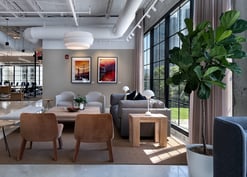In today’s fast-paced, hybrid work environment, companies are rethinking what it means to design for productivity, well-being, and culture. Conventional office design strategies that focus solely on efficiency and spatial layout are giving way to more holistic frameworks that integrate emotional, sensory, and environmental considerations to improve the overall quality of the work experience.
Experiential workplace design is transforming how organizations think about space. This approach centers the employee experience and prioritizes creating inspiring environments that connect people, space, and work to a deeper sense of purpose. While finding meaning in the workplace is traditionally considered a personal responsibility rather than an organizational one, art is emerging as a powerful tool for shaping emotionally resonant, stimulating spaces that foster connection, creativity, and engagement.
Reimagining the Workplace
Experiential workplace design is an approach to creating spaces that center employee well-being and engagement rather than just layout and logistics. It considers not only how a space functions, but how it feels and what it inspires.
Though often used interchangeably, Workplace experience design (WXD) and Experiential workplace design differ in scope and focus:
- Workplace Experience Design (WXD): A broad strategy focused on designing the overall experience of the physical and digital workplace, including how it functions, feels, and supports the people within it. This framework centers the space itself, considering how it can be designed to enhance productivity, wellbeing, and collaboration, such as through office layout, wayfinding, and amenities.
- Experiential Workplace Design: A more specific approach that aims to foster meaning, inspiration, and connection in the workplace, often blending intentional, value-driven interventions with immersive experiences to spark inspiration, foster a sense of belonging, and facilitate more engaging day-to-day experiences.
Ultimately, while WXD addresses the full ecosystem of the workplace experience, including operational systems, organizational culture, and space planning, Experiential workplace design focuses on the quality of the experience.
Why Designing for Employee Experience Matters
This design evolution isn’t just a trend, but a strategic advantage. Companies that invest in employee experience report higher levels of job satisfaction, performance, and employee and customer loyalty (Ahire & Sinha, 2022). The physical work environment plays a critical role in shaping that experience.
Designing for experience means creating environments that respond to people's needs by centering comfort, autonomy, connection, and emotional well-being, When these spaces also reflect an organization's core values, they make employees feel more engaged and empowered, strengthening their connection to the company's mission. (Ronda & de Gracia, 2022). %20(1).jpg?width=700&height=467&name=AD_Michael%20Mac%20Bolster-Houghton%20%20(33)%20(1).jpg)
Art-Based Interventions: Anchoring Experience in Emotion and Meaning
Art-based interventions are a powerful ally in experiential workplace design, offering experiences that evoke emotion, spark reflection, and invite employees to form deeper, more meaningful relationships with the workplace. Much like standing desks and ergonomic chairs respond to employees’ physical needs, experiential design techniques, such as the integration of art, support emotional wellbeing, taking into consideration how a space makes employees feel: does it encourage clearer thought, foster connection, inspire creativity, or ease stress?
As hybrid work work models become more prevelant, emotional resonance is emerging as a critical design priority. Digital work can easily lead to feelings of detachment and fatigue, prompting organizations to create more stimulating and inspiring environments through experiential design (Chen & Chou, 2013).
Art plays a key role in this evolution. When integrated intentionally rather than simply as decoration, art cultivates a positive emotional atmosphere as it can:
- Positively disrupt routine, counteracting monotony
- Spark reflection
- Help employees shift from transactional to imaginative, expansive modes of thought
- Offer visual rest in overstimulating environments
- Reflect company values and foster a sense of belonging
- Serve as a prompt for interpersonal connection and conversation
- Create space for moments of mindfulness (Antal, 2014).
Additionally, artistic interventions are proven to help employees find deeper meaning in their work and workplace. These sources of meaning include alignment between personal values and work, opportunities for personal growth, connection with others, and a sense of broader societal impact. Art offers outlets for these experiences without imposing structure which encourages autonomy while delivering powerful, positive side effects such as higher engagement, deeper connection, and stronger sense of purpose in the workplace (Antal et al., 2018).
How TurningArt Can Help
In today’s experience-driven workplaces, creativity is everyone’s responsibility. Employees at all levels are expected to think critically, solve problems, and adapt, and the spaces they inhabit should support this. Designing for creativity means building dynamic, inspiring, and unexpected spaces.
At TurningArt, we believe that art is more than just decoration: it's a vital element of experiential workplace design. Our curated art programs transform workspaces into places where people feel energized, valued, and connected. Whether through rotating exhibits that bring fresh energy to shared spaces or site-specific installations that tell your company’s story, every piece is selected with intention to align with your workplace goals and enrich the daily experience of your teams.
Connect with an Art Advisor below to learn more!

.jpg?width=332&height=177&name=_MG_0840%20copy%20(2).jpg)


.jpg?width=332&height=177&name=dtBv_067_DSC_2139_DaNil%20(2).jpg)


